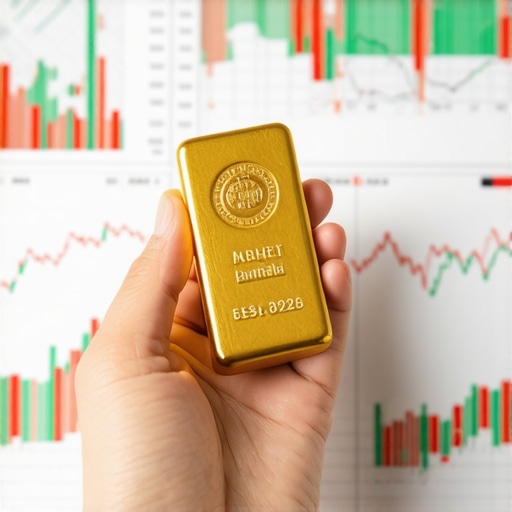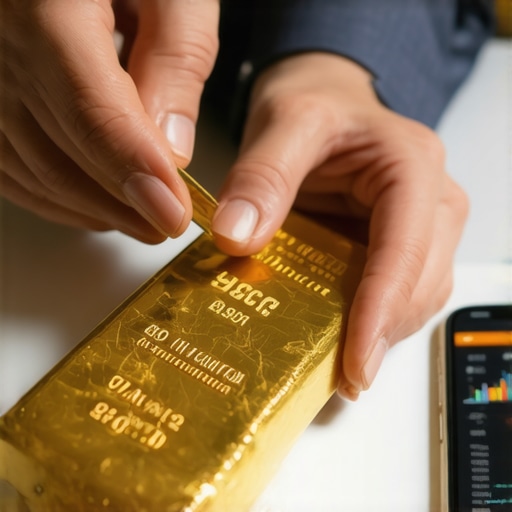Discovering Gold’s Timeless Allure: Why Beginners Should Consider This Precious Metal
Gold has captivated human civilization for millennia, not just as a symbol of wealth but as a resilient financial asset. For beginners stepping into investing, gold offers a unique blend of stability, inflation protection, and diversification. Unlike volatile stocks or cryptocurrencies, gold’s intrinsic value often shines brightest in uncertain economic climates, making it an essential pillar in a well-rounded portfolio.
Unveiling the Path: Practical Steps to Start Your Gold Investment Journey
Embarking on gold investment requires more than just enthusiasm—it demands informed decisions and strategic planning. First, understand the types of gold investments available: physical gold such as coins and bars, gold Exchange-Traded Funds (ETFs), and gold mining stocks. Each option carries distinct risk profiles and liquidity considerations. For instance, owning physical gold offers tangible security but needs safe storage, whereas gold ETFs provide ease of trading but expose you to market volatility.
Next, establish your investment goals and risk tolerance. Are you seeking long-term wealth preservation or short-term gains? Setting clear objectives helps tailor your approach. Moreover, sourcing gold from reputable dealers is critical to avoid counterfeit risks—resources like trusted gold buying guides can be invaluable.
What Are the Key Risks and Rewards When Investing in Gold for Beginners?
While gold is often lauded for its safety, investors must recognize its nuances. Price fluctuations can be influenced by global demand, central bank purchasing trends, and geopolitical events. Unlike dividend-yielding stocks, gold does not generate income, which may affect its attractiveness during bull markets. However, its historical role as a hedge against inflation and currency depreciation remains unparalleled. New investors should balance these factors, possibly combining gold with other assets to optimize portfolio resilience.
Expert Insights: Leveraging Market Trends and Demand Dynamics
Understanding global gold demand trends is pivotal for confident investing. For example, emerging markets’ appetite for gold jewelry and technological applications continues to bolster demand. Additionally, central banks’ strategic gold acquisitions influence supply and price dynamics significantly. Delving into analyses such as global gold demand trends equips investors with a macro perspective that enhances timing and selection strategies.
Embracing Confidence: Tips for Smart and Secure Gold Investment Beginnings
Start small and scale as your knowledge deepens. Diversify across different forms of gold investments to mitigate risk. Prioritize secure storage solutions for physical assets, and consider professional advice or reputable online platforms for purchasing. Staying informed through authoritative sources and continuous market analysis fosters a confident investment mindset.
If you’re ready to dive deeper into safe physical gold investment practices, check out our detailed guide: Beginners Guide to Physical Gold Investment.
Have you started your gold investment journey? Share your experiences or questions in the comments below, and let’s build a community of informed investors.
For further authoritative insights, consider the World Gold Council’s comprehensive research on gold as an investment: World Gold Council Research.
Navigating Gold Market Volatility: Expert Techniques for New Investors
While gold is traditionally viewed as a stable asset, its price is subject to fluctuations driven by complex factors including changes in interest rates, currency strength, and geopolitical tensions. For beginners aiming to harness gold’s potential, understanding these market drivers is crucial. Employing dollar-cost averaging can mitigate timing risks, allowing investors to build positions steadily even amidst volatility. Additionally, monitoring the U.S. dollar index provides insights into gold price movements since gold often inversely correlates with the dollar.
Seasonality also plays a role; demand typically rises during festivals and wedding seasons in key markets such as India and China, influencing short-term price trends. Combining fundamental analysis of supply-demand dynamics with technical chart patterns enhances entry and exit timing decisions, fostering disciplined investment practices.
Integrating Gold with Broader Investment Portfolios: Crafting Resilience
Incorporating gold into a diversified portfolio requires strategic allocation tailored to individual risk tolerance and investment horizons. Allocations between 5% to 15% in gold assets can balance growth potential with risk mitigation. Mixing physical gold with financial instruments like gold ETFs or mining stocks can optimize liquidity and growth opportunities while maintaining the hedge benefits.
Furthermore, gold’s low correlation with equities and bonds makes it an effective tool during market downturns. For retirement-focused investors, gold-backed IRAs offer tax advantages and a stable growth component. Understanding these nuances aids in crafting portfolios that withstand economic uncertainty without sacrificing upside potential.
How Can Emerging Technologies and ESG Trends Influence Gold Investment Strategies?
As environmental, social, and governance (ESG) criteria gain prominence, gold mining companies are increasingly adopting sustainable practices that influence investor decisions. Technologies such as blockchain for supply chain transparency and innovations in eco-friendly mining reduce environmental impact and enhance ethical sourcing credibility.
Investors prioritizing ESG-compliant assets may favor mining stocks or funds that align with these values, reflecting a growing trend in responsible investing. This shift not only affects company valuations but also market perceptions, potentially impacting gold prices and demand patterns. Staying abreast of these developments enables investors to align gold investments with broader societal trends while managing reputational risks.
Leveraging Authoritative Insights: The Role of Data and Research
Accessing comprehensive and reliable data is paramount for expert gold investing. The World Gold Council remains a premier source offering in-depth analysis on supply-demand fundamentals, investment flows, and price forecasts. These insights help anticipate market shifts and adapt strategies proactively.
Additionally, platforms providing real-time market data and analytics empower investors to execute informed trades and manage portfolio risks effectively. Combining these resources with customized investment plans ensures a robust approach to gold investment, even for beginners venturing into this domain.
We invite you to share your perspectives or questions about advanced gold investment strategies in the comments section below. Engaging with a community of knowledgeable investors can enrich your understanding and refine your approach.
Decoding Complex Market Signals: Advanced Analytical Approaches for Gold Investors
For investors venturing beyond the basics, harnessing sophisticated analytical tools is indispensable. Integrating macroeconomic indicators such as real interest rates, inflation expectations, and currency fluctuations with gold price movements can reveal nuanced trends that simpler models overlook. For example, the relationship between real yields and gold prices is inversely proportional; when real yields decline, gold tends to become more attractive as a non-yielding asset.
Moreover, leveraging sentiment analysis from futures markets and positioning data can provide a forward-looking perspective on potential price shifts. Institutional investors often drive these subtle market dynamics, thus understanding their behavior through Commitment of Traders (COT) reports can enhance timing decisions. Complementing these fundamentals with technical indicators like Relative Strength Index (RSI) and Moving Average Convergence Divergence (MACD) further refines entry and exit points.
How Do Geopolitical Risks and Central Bank Policies Intertwine to Shape Gold Price Volatility?
Geopolitical tensions, such as conflicts or trade disputes, often trigger safe-haven flows into gold, causing price spikes. However, central banks’ monetary policies, especially those concerning interest rates and quantitative easing, modulate these reactions. For instance, a dovish stance with low interest rates typically supports higher gold prices by diminishing opportunity costs. Conversely, tightening policies may suppress gold demand temporarily despite geopolitical stress. This interplay creates complex volatility patterns requiring investors to monitor both geopolitical news and central bank communications closely.
Additionally, diversification across global geopolitical risk zones can mitigate localized shocks. Investors should consider how shifts in U.S. Federal Reserve policies, European Central Bank guidance, or emerging market dynamics uniquely influence gold’s price behavior, making a one-size-fits-all approach ineffective.
Harnessing ESG and Technological Innovations: Transforming Gold Investment Paradigms
The gold industry is undergoing a paradigm shift fueled by ESG imperatives and cutting-edge technology adoption. Blockchain-enabled traceability ensures provenance verification, reducing exposure to conflict minerals and unethical sourcing. This transparency not only enhances investor confidence but also appeals to socially conscious consumers, potentially expanding demand.
On the environmental front, advancements in low-impact mining techniques—such as bioleaching and renewable energy integration—are reducing the carbon footprint of gold extraction. These initiatives are increasingly factored into company valuations and fund inclusion criteria, reshaping gold mining equity attractiveness. Investors can capitalize on these trends by selecting ESG-compliant mining stocks or thematic ETFs focused on sustainable precious metals.
Integrating ESG considerations with traditional financial analysis results in a more holistic investment thesis that anticipates regulatory shifts and evolving market preferences.
Optimizing Portfolio Resilience: Strategic Allocation and Risk Management Techniques
Beyond mere inclusion, the strategic allocation of gold within portfolios demands an understanding of dynamic correlations and scenario-based stress testing. Employing tools like Monte Carlo simulations or Value at Risk (VaR) models allows investors to quantify potential losses and optimize allocations accordingly. These quantitative methods reveal how gold behaves under various economic conditions, informing tactical adjustments.
Furthermore, dynamic rebalancing based on market indicators and personal risk tolerance can enhance returns while preserving capital. For instance, increasing gold exposure during inflationary regimes and trimming it when equity markets outperform aligns with an adaptive investment framework.
New investors should also consider liquidity constraints and transactional costs when selecting gold investment vehicles, balancing ease of access with cost efficiency.
We encourage readers to delve deeper into these advanced methodologies and share your experiences or questions to foster a sophisticated dialogue on gold investment strategies.
For an authoritative and comprehensive resource on gold market analysis and investment tactics, visit the World Gold Council’s Research Hub, which offers data-driven insights and expert commentary.
Decoding Macro-Financial Indicators: Enhancing Gold Investment Precision
To master gold investing beyond conventional wisdom, one must integrate a spectrum of macro-financial signals that intricately influence gold’s price trajectory. Understanding the inverse relationship between real interest rates and gold prices reveals underlying demand pressures for this non-yielding asset. When real yields diminish due to inflationary trends or accommodative monetary policies, gold’s allure intensifies as an inflation hedge and store of value. Investors who incorporate real-time analysis of inflation expectations and currency fluctuations position themselves advantageously to anticipate market inflection points.
How Can Advanced Analytical Frameworks Improve Timing and Risk Management in Gold Investments?
Employing sophisticated tools such as sentiment analysis derived from futures market positioning, combined with Commitment of Traders (COT) reports, provides granular insights into institutional investor behavior. This data, when cross-referenced with technical indicators like Relative Strength Index (RSI) and Moving Average Convergence Divergence (MACD), refines entry and exit strategies with greater precision. Additionally, scenario analysis involving geopolitical risk assessments and central bank policy shifts enables dynamic portfolio adjustments to mitigate volatility and capitalize on safe-haven demand surges.
For an authoritative exploration of these advanced methodologies, the World Gold Council’s Research Hub offers comprehensive data and expert commentary tailored for sophisticated investors.
Integrating ESG and Technological Disruptions: Redefining Ethical Gold Investing
The confluence of Environmental, Social, and Governance (ESG) imperatives and blockchain technology is revolutionizing the gold investment landscape. Blockchain-enabled provenance tracking ensures unparalleled transparency in sourcing, effectively mitigating risks associated with conflict minerals and unethical mining practices. Concurrently, innovations such as bioleaching and renewable energy adoption in gold extraction curtail environmental footprints, elevating the ESG profiles of mining entities.
Investors increasingly prioritize ESG compliance, influencing valuations and driving demand for sustainably mined gold and thematic ETFs. This paradigm shift necessitates a dual-focus investment thesis that synthesizes traditional financial metrics with evolving societal values and regulatory frameworks, thereby future-proofing portfolios against reputational and regulatory risks.
Strategic Portfolio Optimization: Dynamic Allocation and Quantitative Risk Assessment
Optimizing gold’s role in a diversified portfolio transcends static allocation models, requiring adaptive strategies informed by rigorous quantitative analysis. Techniques such as Monte Carlo simulations and Value at Risk (VaR) modeling provide probabilistic insights into potential drawdowns and return distributions under varying macroeconomic scenarios. These approaches empower investors to calibrate gold exposure dynamically, enhancing resilience amid inflationary pressures or equity market downturns.
Moreover, integrating tactical rebalancing based on leading economic indicators and personal risk thresholds maximizes returns while safeguarding capital. Consideration of liquidity constraints and transaction costs further refines vehicle selection, balancing accessibility with cost efficiency.
Engage with our community by sharing your advanced gold investing experiences or questions below, and elevate your strategic approach through collaborative insights.
Frequently Asked Questions (FAQ)
What are the primary benefits of including gold in an investment portfolio?
Gold serves as a hedge against inflation, currency devaluation, and geopolitical uncertainties. Its low correlation with equities and bonds helps diversify risk, stabilize portfolio returns during market volatility, and preserve wealth over long-term horizons.
How can beginners safely start investing in physical gold?
Beginners should purchase physical gold through reputable dealers verified by industry standards to avoid counterfeits. Secure storage solutions such as insured vaults or safety deposit boxes are essential. Starting with smaller quantities and gradually increasing exposure while educating oneself helps build confidence and mitigate risks.
What factors drive gold price volatility and how can investors manage them?
Gold prices fluctuate due to real interest rates, inflation expectations, currency strength, geopolitical events, and central bank policies. Investors can manage volatility by employing dollar-cost averaging, monitoring macroeconomic indicators, diversifying gold investment types, and using technical analysis to time entries and exits effectively.
How do ESG considerations impact gold mining investments?
Environmental, Social, and Governance (ESG) factors influence investor preference and company valuations. Mining firms adopting sustainable practices, transparent supply chains via blockchain, and eco-friendly technologies tend to attract responsible investors, potentially enhancing demand and reducing reputational risks associated with unethical mining.
What advanced analytical tools can improve gold investment decision-making?
Sentiment analysis from futures markets, Commitment of Traders (COT) reports, and technical indicators like RSI and MACD provide insights into market positioning and momentum. Combining these with macroeconomic data such as real yields and inflation expectations enables refined timing and risk management strategies.
How do geopolitical risks interplay with central bank policies to affect gold prices?
Geopolitical tensions often increase gold’s safe-haven appeal, driving prices upward. However, central bank actions—especially interest rate adjustments and quantitative easing—modulate these effects by influencing opportunity costs and liquidity. Investors must monitor both geopolitical developments and policy shifts to anticipate price movements accurately.
What is the optimal allocation of gold within a diversified portfolio?
While individual risk tolerance varies, allocations between 5% and 15% in gold-related assets typically balance growth and risk mitigation. Dynamic rebalancing based on economic conditions and personal goals further enhances portfolio resilience and return potential.
How do technological innovations like blockchain transform gold investing?
Blockchain enhances supply chain transparency by verifying the provenance of gold, reducing exposure to conflict minerals and unethical sourcing. This technology builds investor confidence, supports ESG compliance, and may broaden market demand for traceable, responsibly sourced gold products.
Can gold investment strategies adapt to changing macroeconomic environments?
Yes, advanced investors incorporate real-time macro-financial indicators such as inflation trends, currency movements, and central bank policies into their strategies. Techniques like Monte Carlo simulations and Value at Risk (VaR) modeling assist in adjusting allocations and managing risk dynamically to optimize outcomes.
What role do gold-backed IRAs play in retirement planning?
Gold-backed Individual Retirement Accounts (IRAs) offer tax advantages and portfolio diversification for retirement investors. They provide a stable asset component that can protect against inflation and market downturns, complementing traditional equity and bond holdings within a long-term retirement strategy.
Trusted External Sources
- World Gold Council (https://www.gold.org): Offers comprehensive research on gold supply-demand fundamentals, market trends, investment flows, and ESG initiatives, serving as a cornerstone resource for both novice and expert investors.
- London Bullion Market Association (LBMA) (https://www.lbma.org.uk): Provides authoritative standards on gold bullion trading, certification, and market data essential for understanding global physical gold markets.
- International Monetary Fund (IMF) (https://www.imf.org): Delivers macroeconomic data and analysis relevant to gold price drivers such as interest rates, inflation, and central bank reserves.
- Bloomberg Professional Service (https://www.bloomberg.com/professional): Supplies real-time market data, advanced analytics, and sentiment indicators crucial for sophisticated gold investment decision-making.
- Journal of Sustainable Finance & Investment: Publishes peer-reviewed research on ESG integration and technological innovations shaping the future of responsible gold investing.
Conclusion
Gold remains a timeless cornerstone of diversified investment portfolios, offering unique advantages as a hedge against inflation, geopolitical risk, and currency fluctuations. Starting with a solid understanding of gold’s market dynamics, risk factors, and investment vehicles empowers both beginners and seasoned investors to craft resilient strategies. The growing importance of ESG considerations and technological innovations such as blockchain will increasingly shape gold’s investment landscape, aligning financial objectives with ethical imperatives.
Advanced analytical frameworks that integrate macro-financial indicators, sentiment data, and technical analysis enhance precision and timing, while dynamic portfolio allocation methods optimize risk and return profiles. Whether through physical gold, ETFs, mining stocks, or retirement accounts, informed gold investment fosters long-term wealth preservation and growth.
We encourage you to apply these expert insights, share your perspectives, and explore further authoritative content to elevate your gold investment journey. Engage with our community by commenting below and stay informed with ongoing research from trusted sources to navigate the evolving gold market landscape confidently.










